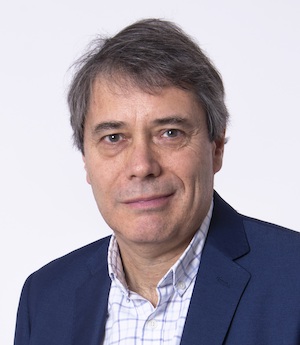We spoke with Robert Navarro (Lic&MBA 86), the new president of the Esade Alumni Energy and Environment Club and Managing Director and CEO of RWE Renewables Iberia, about the role of renewable energy sources in sustainability plans.

As part of the European Green Deal, the European Union has a clear vision: to transform itself into a modern, competitive and resource-efficient economy, thereby guaranteeing net-zero greenhouse gas emissions by 2050. Energy is the key to achieving this goal, as it is currently responsible for more than 90% of CO₂ emissions. To find out more about the role of renewable energy in this scenario, we spoke with Robert Navarro (Lic&MBA 86), the new president of the Esade Alumni Energy and Environment Club and Managing Director and CEO of RWE Renewables Iberia.
 As a venue for members to debate and share useful information on all matters related to the world of energy, the Esade Alumni Energy and Environment Club aims to address concerns arising from the many challenges that lie ahead. “Our sector is absolutely essential to the future of humanity as well as to the business world,” explained Robert. “The club that I have the privilege of leading wants to be at the forefront of all of this.” His activities cover a wide range of topics and the energy transition is always front and centre.
As a venue for members to debate and share useful information on all matters related to the world of energy, the Esade Alumni Energy and Environment Club aims to address concerns arising from the many challenges that lie ahead. “Our sector is absolutely essential to the future of humanity as well as to the business world,” explained Robert. “The club that I have the privilege of leading wants to be at the forefront of all of this.” His activities cover a wide range of topics and the energy transition is always front and centre.
Energy challenges
“Far beyond the urgent matters arising from the sad reality of the war in Ukraine, the greatest challenge facing humanity is the struggle to prevent the gradual degradation of the planet, the greatest – but not only – example of which is the climate crisis,” explained Robert. “Therefore, we need a consensus-based, coordinated global effort that, in matters pertaining to energy, essentially focuses on reducing consumption and ensuring that it is powered by renewable sources.”
n the field of energy generation, the path is already well mapped out, although the challenge of guaranteeing supply has yet to be resolved, In the field of transport, however, we have barely begun our journey along the unavoidable path towards decarbonisation.
The difficulties that must be overcome are diverse and varied. “The challenges range from occasional rejection by local communities of new wind or solar plants – it must be noted that, comparatively speaking, these facilities take up much more space than conventional plants – to issues relating to mobility, which is neither simple nor quick to disengage from fossil fuels, not to mention the need to guarantee supply from intermittent primary sources such as the sun or wind, the ability finance all this, and the need to guarantee that no one is left behind at any point in the process. All in all, it’s complex, but necessarily manageable,” declared Robert.
We need a consensus-based, coordinated global effort that, in matters pertaining to energy, essentially focuses on reducing consumption and ensuring that it is powered by renewable sources
New technologies as a response
Green hydrogen, advanced batteries and other forms of long-life storage are technologies that can provide carbon-free electricity and long-term electricity storage, relieve grid congestion, increase reliability and facilitate the integration of solar and wind power into the grid, all while supporting 100% clean energy goals.
The future requires promoting research and innovation that will allow us to further improve the various technologies in terms of reliability, competitiveness and energy density. Much progress has been made in recent years, and further progress is expected on the path towards achieving fully reliable and highly competitive storage systems.
Hydrogen is not an energy source per se, but rather a transmission vector. Its production requires a primary source; therefore, in order to be truly sustainable, it must be generated from renewable energy sources – hence the name green hydrogen. “Once this step has been taken – and assuming we manage to reduce production costs – we are looking at a very useful tool, in terms of its energy density and transmissibility as well as its capacity to cover thermal processes that cannot be electrified,” explained Robert.
The future requires promoting research and innovation that will allow us to further improve the various technologies in terms of reliability, competitiveness and energy density
In this scenario, the replacement of conventional generation with cheaper renewable generation should lead to an overall reduction in costs. “In fact, although you may not realise it, we are already experimenting: our current situation would be much worse without the renewable generation we already enjoy,” said Robert. “The electrification of transport also brings and will bring significant savings, so overall we can be optimistic.”
The challenge at the heart of Europe’s green transition is to ensure that the associated benefits and opportunities are available to all, as quickly and as fairly as possible. By using the various tools available to us, we can guarantee change. We all need to be a part of this transformation.


 As a venue for members to debate and share useful information on all matters related to the world of energy, the Esade Alumni Energy and Environment Club aims to address concerns arising from the many challenges that lie ahead. “Our sector is absolutely essential to the future of humanity as well as to the business world,” explained Robert. “The club that I have the privilege of leading wants to be at the forefront of all of this.” His activities cover a wide range of topics and the energy transition is always front and centre.
As a venue for members to debate and share useful information on all matters related to the world of energy, the Esade Alumni Energy and Environment Club aims to address concerns arising from the many challenges that lie ahead. “Our sector is absolutely essential to the future of humanity as well as to the business world,” explained Robert. “The club that I have the privilege of leading wants to be at the forefront of all of this.” His activities cover a wide range of topics and the energy transition is always front and centre.




























